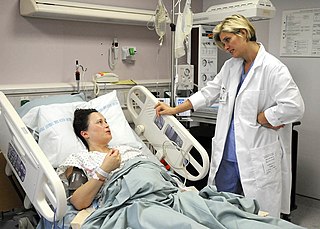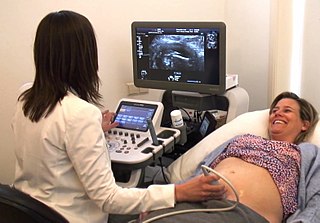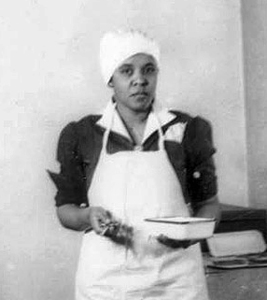Related Research Articles

Midwifery is the health science and health profession that deals with pregnancy, childbirth, and the postpartum period, in addition to the sexual and reproductive health of women throughout their lives. In many countries, midwifery is a medical profession. A professional in midwifery is known as a midwife.

A doula is a trained professional who provides expert guidance for the service of others and who supports another person through a significant health-related experience, such as childbirth, miscarriage, induced abortion or stillbirth, as well as non-reproductive experiences such as dying. A doula may also provide support to the client's partner, family, and friends.

A birthing center is a healthcare facility, staffed by nurse midwives, midwives and/or obstetricians, for mothers in labor, who may be assisted by doulas and coaches. The midwives monitor the labor, and well-being of the mother and the baby during birth. Doulas can assist the midwives and make the birth easier. Should additional medical assistance be required, the mother can be transferred to a hospital. This transfer is more likely if an epidural is needed, there is meconium staining, it is a prolonged labor, or the newborn needs intensive care. Some hospitals have birth centers as an alternative to the usual high tech maternity wards.

Ina May Gaskin is an American midwife who has been described as "the mother of authentic midwifery." She helped found the self-sustaining community, The Farm, with her husband Stephen Gaskin in 1971 where she markedly launched her career in midwifery. She is known for the Gaskin Maneuver, has written several books on midwifery and childbirth, and continues to educate society through lectures and conferences and spread her message of natural, old-age inspired, fearless childbirth.

In the United States, a Certified Nurse-Midwife (CNM) is a nurse midwife who exceeds the International Confederation of Midwives essential competencies for a midwife and is also an advanced practice registered nurse, having completed registered nursing and midwifery education leading to practice as a nurse midwife and credentialing as a Certified Nurse-Midwife. CNMs provide care of women across their lifespan, including pregnancy and the postpartum period, and well woman care and birth control. Certified Nurse-Midwives are exceptionally recognized by the International Confederation of Midwives as a type of midwife in the U.S.

The Frontier Nursing Service (FNS) provides healthcare services to rural, underserved populations since 1925, and educates nurse-midwives since 1939.
The Association of Radical Midwives (ARM) is a UK organisation for midwives, doulas, mothers, and anyone concerned with the health of maternity services.
A birth attendant, also known as skilled birth attendant, is a health professional who provides basic and emergency care to women and their newborns during pregnancy, childbirth and the postpartum period. A birth attendant, who may be a midwife, physician, obstetrician, or nurse, is trained to be present at ("attend") childbirth, whether the delivery takes place in a health care institution or at home, to recognize and respond appropriately to medical complications, and to implement interventions to help prevent them in the first place, including through prenatal care. Different birth attendants are able to provide different levels of care.

The Promotion of the Welfare and Hygiene of Maternity and Infancy Act, more commonly known as the Sheppard–Towner Act, was a 1921 U.S. Act of Congress that provided federal funding for maternity and childcare. It was sponsored by Senator Morris Sheppard (D) of Texas and Representative Horace Mann Towner (R) of Iowa and signed by President Warren G. Harding on November 23, 1921. It went out of effect in 1929.

A monthly nurse is a woman who looks after a mother and her baby during the postpartum or postnatal period. The phrase is now largely obsolete, but the job continues under other names and conditions worldwide.
Ruth Watson Lubic, CNM, EdD, FAAN, FACNM, is an American nurse-midwife and applied anthropologist who pioneered the role of nurse-midwives as primary care providers for women, particularly in maternity care. Lubic is considered to be one of the leaders of the nurse-midwifery movement in the United States.
This article deals with childbirth in Japan, and the specific details of childbirth exclusive to Japan in relation to beliefs, attitudes and healthcare.
In the United States, certified nurse midwives (CNMs) are advanced practice registered nurses in nurse midwifery, the nursing care of women during pregnancy and the postpartum period. CNMs are considered as midwives.
Midwives in the United States assist childbearing women during pregnancy, labor and birth, and the postpartum period. Some midwives also provide primary care for women including well-woman exams, health promotion, and disease prevention, family planning options, and care for common gynecological concerns. Before the turn of the 20th century, traditional midwives were informally trained and helped deliver almost all births. Today, midwives are professionals who must undergo formal training. Midwives in the United States formed the Midwifery Education, Regulation, and Association task force to establish a framework for midwifery.

A direct-entry midwife is a midwife who has become credentialed without first becoming a nurse. There are direct-entry midwifery programs that prepare students to become Certified Nurse Midwives (CNMs) or Certified Professional Midwives (CPMs). Certified Professional Midwives are known for being "more natural and less intervention oriented." In other words, these midwives typically work outside of the hospital setting in homes and birth centers and do not employ methods for childbirth that physicians in hospitals commonly use such as caesarean section, forceps and other types of equipment and drugs.

A midwife is a health professional who cares for mothers and newborns around childbirth, a specialization known as midwifery.

Ronnie Sue Lichtman, is a midwife, educator, writer and advocate for women's health. She has published widely for both lay and professional audiences. The Chair of the Midwifery Education Program at The State University of New York (SUNY) Downstate Medical Center in New York City, she earned a Ph.D. in sociomedical sciences from Columbia University Graduate School of Arts and Sciences, and her MS in Maternity Nursing with a specialization in midwifery from Columbia University School of Nursing. She previously directed the midwifery programs at Columbia University and Stony Brook University.

A nurse midwife is both a nurse and a midwife, having completed nursing and midwifery education leading to practice as a nurse midwife and sometimes credentialed in the specialty. Nurse midwives provide care of women across the lifespan, including during pregnancy and the postpartum period, and well woman care and birth control.
Angela Murdaugh is an American Catholic religious sister in the Franciscan Sisters of Mary, a Certified Nurse‐Midwife. She was a pioneer in promoting nurse midwives and birth centers. Out of this passion, she founded the Holy Family Birth Center in Weslaco, TX in 1983.

Mamie Odessa Hale was a leader in public health and a midwife consultant who worked in Arkansas for the Department of Health from 1945 to 1950. During this time, Hale's objective was to educate and train 'granny midwives.' Her efforts were in place to address the public health disparity between black and white women that was currently evident.
References
- 1 2 3 4 Rocks, Judith; Charles S. Mahan (1999). Midwifery and Childbirth in America. Temple University Press. pp. 37–39. ISBN 1-56639-711-1.
- 1 2 3 "Archived copy" (PDF). Archived from the original (PDF) on 2009-08-15. Retrieved 2009-05-31.
{{cite web}}: CS1 maint: archived copy as title (link) - ↑ Davis-Floyd, Robbie; Christine Barbara Johnson (2006). Mainstreaming Midwives. CRC Press. pp. 90–91. ISBN 0-415-93151-7.
- ↑ Rocks, Judith; Charles S. Mahan (1999). Midwifery and Childbirth in America. Temple University Press. pp. 74–75. ISBN 1-56639-711-1.
- 1 2 3 4 5 6 Holz, Rose (2017). "The 1939 Dickinson-Belskie Birth Series Sculptures: The Rise of Modern Visions of Pregnancy, the Roots of Modern Pro-Life Imagery, and Dr. Dickinson's Religious Case for Abortion". Papers in Women's and Gender Studies.
- ↑ "Why We Changed Our Name | About Us :: Childbirth Connection". Archived from the original on 2009-10-10. Retrieved 2009-05-31.
- ↑ "WWW Health Awards (Spring/Summer 2006 Winners List)" (PDF). Healthawards.com. Retrieved 27 June 2019.
- ↑ "About the Transforming Maternity Care Partnership - Transforming Maternity Care". Transform.childbirthconnection.org. Archived from the original on 11 September 2019. Retrieved 27 June 2019.
- ↑ Barnes, Robert; Shear, Michael D. (2009-05-29). "White House Tries to Quell Abortion Rights Supporters' Fears About Sotomayor". The Washington Post. Retrieved 2010-04-28.